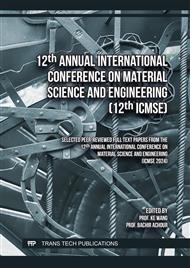[1]
A. Hossain, M. Skalicky, M. Brestic, S. Maitra, S. Sarkar, Z. Ahmad, H. Vemuri, S. Garai, M. Mondal, R. Bhatt, P. Kumar, P. Banerjee, S. Saha, T. Islam and A. M. Laing, "Selenium biofortification: roles, mechanisms, responses and prospects", Molecules, vol. 26, p.881, 2021.
DOI: 10.3390/molecules26040881
Google Scholar
[2]
A. Khan, S. Khan, M. A. Khan, Z. Qamar and M. Waqas, "The uptake and bioaccumulation of heavy metals by food plants, their effects on plants nutrients, and associated health risk: a review", Environmental science and pollution research, vol. 22, pp.13772-13799, 2015.
DOI: 10.1007/s11356-015-4881-0
Google Scholar
[3]
R. Gong, C. Ai, B. Zhang and X. Cheng, "Effect of selenite on organic selenium speciation and selenium bioaccessibility in rice grains of two Se-enriched rice cultivars", Food chemistry, vol. 264, pp.443-448, 2018.
DOI: 10.1016/j.foodchem.2018.05.066
Google Scholar
[4]
J. Zhao, Y. Yang, K. Zhang, J. Jeong, Z. Zeng and H. Zang, "Does crop rotation yield more in China? A meta-analysis", Field Crops Research, vol. 245, p.107659, 2020.
DOI: 10.1016/j.fcr.2019.107659
Google Scholar
[5]
A. Kabate-Pendias and H. Pendias, "Trace elements in soils and plants" Boca Raton, Florida: CRC Press, 2001.
Google Scholar
[6]
M. Gupta and S. Gupta, "An overview of selenium uptake, metabolism, and toxicity in plants", Frontiers in plant science, vol. 7, p.2074, 2017.
DOI: 10.3389/fpls.2016.02074
Google Scholar
[7]
K. H. Liu, Y.T. Fang, F.M. Yu, Q. Liu, F. R. Li and S.L. Peng, "Soil acidification in response to acid deposition in three subtropical forests of subtropical China", Pedosphere, vol. 20, pp.399-408, 2010.
DOI: 10.1016/s1002-0160(10)60029-x
Google Scholar
[8]
A. Zayed, C. M. Lytle and N. Terry, "Accumulation and volatilization of different chemical species of selenium by plants", Planta, vol. 206, pp.284-292, 1998.
DOI: 10.1007/s004250050402
Google Scholar
[9]
S. Fernandez, S. Seoane and A. Merino. "Plant heavy metal concentrations and soil biological properties in agricultural serpentine soils", Communications in Soil Science and Plant Analysis, vol. 30, pp.1867-1884, 1999.
DOI: 10.1080/00103629909370338
Google Scholar
[10]
M. Shahid, N. K. Niazi, S. Khalid, B. Murtaza, I. Bibi, and M. I. Rashid, "A critical review of selenium biogeochemical behavior in soil-plant system with an inference to human health", Environmental pollution, vol. 234, pp.915-934, 2018.
DOI: 10.1016/j.envpol.2017.12.019
Google Scholar
[11]
T. Alekseeva, A. Alekseev, R. K. Xu, A. Z. Zhao and P. Kalinin, "Effect of soil acidification induced by a tea plantation on chemical and mineralogical properties of Alfisols in eastern China", Environmental geochemistry and health, vol. 33, pp.137-148, 2011.
DOI: 10.1007/s10653-010-9327-5
Google Scholar
[12]
M. Qaswar, H. Jing, W. Ahmed, D. Li, S. Liu, L. Zhang, A. Cai, L. Liu, Y. Xu, J. Gao and H. Zhang, "Yield sustainability, soil organic carbon sequestration and nutrients balance under long-term combined application of manure and inorganic fertilizers in acidic paddy soil", Soil and Tillage Research, vol. 198, p.104569, 2020.
DOI: 10.1016/j.still.2019.104569
Google Scholar
[13]
V. K. Sharma, T. J. McDonald, M. Sohn, G. A. K. Anquandah, M. Pettine and R. Zboril, "Biogeochemistry of selenium. A review", Environmental Chemistry Letters, vol. 13, pp.49-58, 2015.
DOI: 10.1007/s10311-014-0487-x
Google Scholar
[14]
Z. Li, D. Zhu, J. H. Lindhardt, S. M. Lin, X. Ke and L. Cui, "Long-term fertilization history alters effects of microplastics on soil properties, microbial communities, and functions in diverse farmland ecosystem", Environmental Science & Technology, vol. 55, pp.4658-4668, 2021.
DOI: 10.1021/acs.est.0c04849
Google Scholar
[15]
Z. Li, D. Liang, Q. Peng, Z. Cui, J. Huang and Z. Lin, "Interaction between selenium and soil organic matter and its impact on soil selenium bioavailability: A review", Geoderma, vol. 295, pp.69-79, 2017.
DOI: 10.1016/j.geoderma.2017.02.019
Google Scholar
[16]
B. Zhang, Y. Wei, S. Yan, H. Shi, Y. Nie, G. Zou, X, Zhang and L. Luo, "Characterization of selenium accumulation of different rice genotypes in Chinese natural seleniferous soil" Plant, Soil & Environment, vol. 65, pp.15-20, 2019.
DOI: 10.17221/603/2018-pse
Google Scholar



